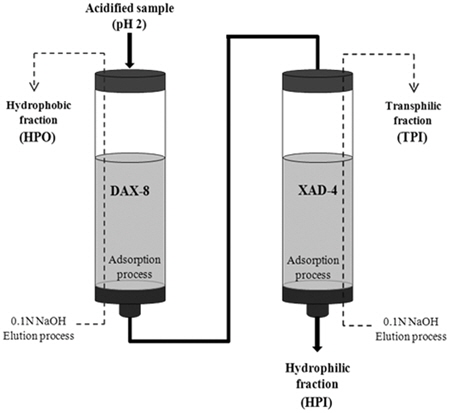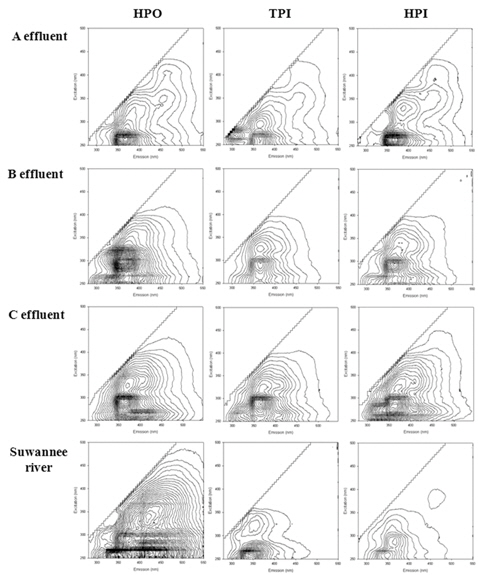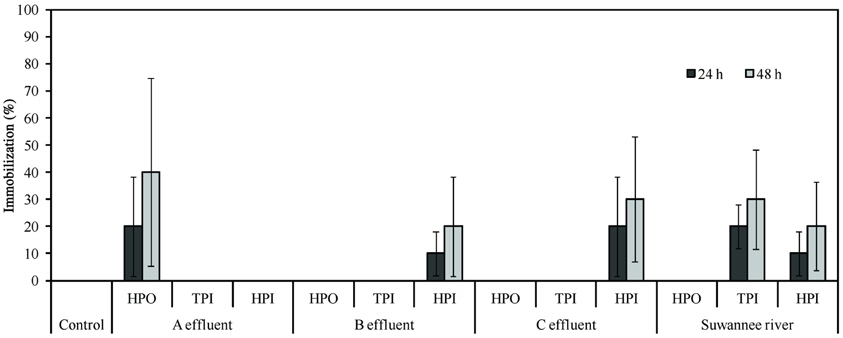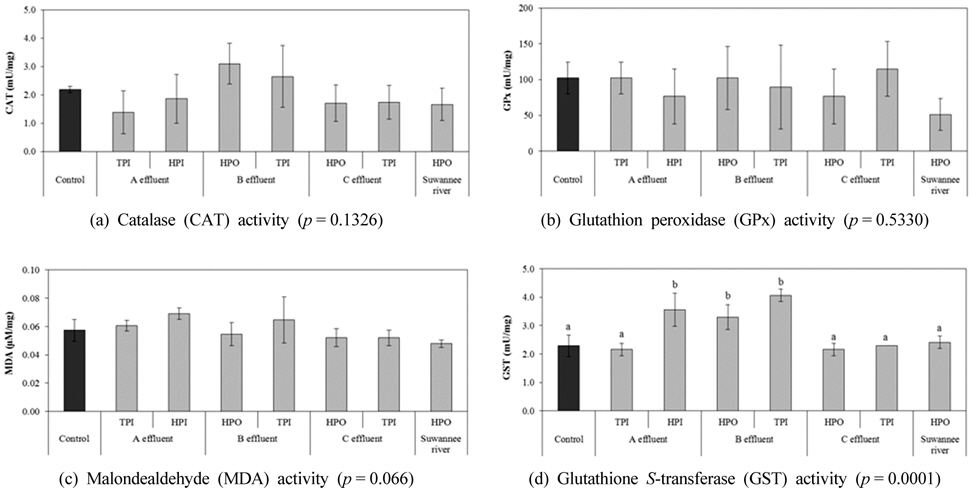


Unlike to natural organic matters (NOMs), effluent organic matters (EfOMs) are not well understood due to their complexity and heterogeneity. In this study, EfOMs from sewage and industrial wastewater treatment effluents and Suwannee River NOM (SRNOM) were isolated into hydrophobic (HPO), transphilic (TPI) and hydrophilic (HPI) fractions. Specific ultraviolet absorbance (SUVA) and fluorescence excitation emission matrix (FEEM) analyses were used to characterize physicochemical properties. In addition, acute toxicity and oxidative stress to
방류수유기물질(Effluent organic matter, EfOM)은 일반적으로 하폐수처리장으로부터 수계로 유입되는 유기물질을 총칭하며, 수생태계에 악영향을 미칠 수 있는 유기물질로 알려져 있다(Shon et al., 2006). 또한, EfOM은 수계 내 유해물질인 유기화합물과 중금속의 거동에 영향을 미침으로서 궁극적으로 수서생물에 대한 이들의 독성을 변화시킬 수 있다(Ruhle et al., 2012; Yu et al., 2012). 따라서 EfOM의 구성성분을 확인하고 물리화학적 특성을 분석하는 연구는 이들이 수계에 미치는 영향을 평가하는데 매우 중요하다(Quaranta et al., 2012; Shon et al., 2006).
유기물의 흡광 및 형광 특성은 자연유기물질(Natural organic matter, NOM)의 물리화학적 특성을 파악할 수 있는 좋은 지표로 이용되었다(Baker and Spencer, 2004; Senesi et al., 1991; Yamashita and Tanoue, 2003). 이전 연구들에 따르면(Al-Reasi et al., 2013; Chen et al., 2009; Dong and Rosario-Ortiz, 2012; Thurman, 1985), EfOM은 SUVA(Specific ultraviolet absorbance)값이 1.9-2.2 L m-1 mg-1으로 소수성이 낮은 생분해성 유기물질로 구성되어 있으며, FI(Fluorescence index)값은 1.85-2.06으로 미생물 기원 유기물로 분류되었다. 특히 EfOM은 40%이상이 생분해성이 높은 친수성 유기물질로 이루어져 있는데 이는 생물학적 처리 이후 탄수화물과 아미노산 등이 증가하였기 때문이다. 그러나 하천수 NOM은 EfOM보다 훨씬 높은 SUVA값을 나타내어 소수성 물질이 많이 포함되어 있는 것으로 확인되었고, FI값은 1.2이하로 EfOM 보다 낮은 값을 나타내었다. 이를 통해 EfOM과 NOM이 매우 다른 물리화학적 특성을 가지는 다른 기원의 유기물질이라는 것을 알 수 있다.
한편 국내에서 Seo et al. (2010)은 영산강 유역의 NOM과 하수처리장 EfOM의 TOC, BOD, COD 분석과 DOC 생분해 실험을 통해 각 유기물의 분포와 분해 특성을 파악하였다. 또한 Lee, Chon et al. (2011)은 영산강 유역의 NOM과 하수처리장 EfOM을 소수성과 친수성 유기물로 분획하여 각 유기물의 작용기를 분석하고 각 유기물질에 대한 분포특성을 연구하였다. 그리고 Lee, Chon et al. (2011)은 하수처리장 방류수 유래 유기물질을 입자 크기별 및 극성별로 구분하고 17β-estradiol(E2)와의 결합 특성을 규명한 바 있다.
이와 같이 NOM과 함께 EfOM에 대한 연구가 최근에는 국내에서도 활발하게 진행되고 있지만, 다양한 성상의 방류수로부터 유래되는 유기물의 물리화학적 특성과 함께 수서생물에 미치는 직간접적인 영향을 비교하여 연구한 사례는 전무한 실정이다. 따라서 본 연구는 하폐수처리장 유래 EfOM을 극성별로 분리한 후 이들의 흡광 및 형광특성을 NOM과 비교하고, 방류수 생태독성 시험종인 물벼룩에 미치는 급성독성 및 산화적 스트레스를 평가하고자 한다.
본 연구에 사용된 방류수는 금강 미호천 유역에 위치한 3곳의 하폐수처리장에서 2013년 3월 25일 오후 2-5시에 채취하였다(Table 1). A 하수처리장은 산화구법을 이용하여 생활하수를 주로 처리하며, B 폐수처리장은 활성슬러지법을 이용하여 산업폐수를 처리한다. 또한 C 처리장은 생활하수와 축산폐수를 고도처리방법인 A2/O공법을 이용하여 처리한다.
[Table 1.] Sampling location and sample properties

Sampling location and sample properties
각 시료의 수질은 pH, 용존산소(DO), 염도, 전기전도도, 중금속, 용존유기탄소(DOC)를 분석하였다. 수온, pH, DO, 전기전도도는 현장에서 수질다항목측정기(YSI-556, Yellow Springs Instruments, USA)를 이용하여 측정하였고, 중금속 농도는 유도결합플라즈마 분광계(ICP-AES, Varian Vista PRO, USA)를 이용하여 분석하였다. 또한, DOC는 Shimadzu TOC 5000A (Japan)를 사용하여 측정하였다.
EfOM의 극성별 특성분석을 위하여, 채취한 방류수의 유기물을 소수성(Hydrophobic fraction; HPO), 반친수성(Transphilic fraction; TPI), 친수성(Hydrophilic fraction; HPI)으로의 분획하였다. 흡착수지로 DAX-8(Sigma-Aldrich Co.)과 XAD-4(Amberlite, Rohm & Haas Co.)를 사용하였으며(Fig. 1), 컬럼은 원통형 유리 컬럼(25 mm × 300 mm)을 이용하였다(Malcolm and MacCarthy, 1992). 그리고 EfOM과의 비교 연구를 위하여, IHSS(International Humic Substance Society: 국제휴믹물질 학회)에서 구입한 Suwannee river NOM(SRNOM)을 표준 NOM으로 사용하였다. 희석용액은 이온화 세기의 영향을 배제하기 위하여 담수의 이온화 세기와 유사한 0.01 M NaCl을 사용하였다.
구체적으로 DAX-8과 XAD-4 수지는 아세톤, 메탄올, 아세톤, 메탄올, 초순수 순으로 세정하였으며, 0.1 N NaOH와 HCl, 초순수를 반복적으로 수지에 통과시켜 마지막 용리액의 DOC가 0.03 ~ 0.05 mg L-1이 되도록 준비하였다. 그리고 컬럼에 시료를 통과시키기 전에 먼저 1 N HCl을 이용하여 시료의 pH를 2로 조절하였다. 이후 소수성 성분(HPO)의 분리를 위하여 시료를 DAX-8 수지가 충진된 컬럼에 약 2 mL/min 유량으로 통과시킨 다음, 흡착성분을 0.1 N NaOH로 용리하였다. 그리고 반친수성(TPI) 성분 분획은 XAD-4 수지를 이용하여 위와 동일한 방법으로 수행하였으며, 두 컬럼 모두를 통과한 유출수를 친수성(HPI)으로 분획하였다(Aiken et al., 1992; Croue et al., 2003; Ma et al., 2001). 분획 후에 소수성, 반친수성, 친수성 유기물에 존재하는 양이온 및 중금속의 영향을 배제하기 위하여 양이온 교환(Amberlite IR-120H, Aldrich)을 실시하였다.
UV 흡광도는 시료를 GF/F 필터로 여과시킨 후 Mecasys사의 UV-Vis Spectrophotometer (model Optizen POP)를 이용하여 측정하였다. 그리고 UV 254 nm에서 측정한 specific UV-absorption (SUVA) 값은 아래 식을 이용하여 계산하였다.
SUVA (L m-1mg-1) = UVA (cm-1) / DOC (mg L-1) × 100 cm/m
Fluorescence excitation(Ex: 여기파장)-emission(Em: 방출파장) matrix(FEEM)은 Perkin-Elmer사의 LS50B luminescene spectrometer를 이용하여 분석하였다. 시료의 inner-filter correction 과정을 생략하기 위해, 시료를 GF/F 필터로 여과한 후 UV 254 nm에서 측정한 흡광도가 0.1 이하가 되도록 희석하였다(Baker, 2001). 이후 입자성 및 용존성 유기물과 중금속의 영향을 최소화하기 위하여 시료의 pH을 1 N HCl 용액을 사용하여 3.0으로 조절하였다(Westerhoff et al., 2001).
형광 측정 시 형광분광계의 여기파장과 방출파장을 조절하는 슬릿을 각각 10 nm로 고정하여 사용하였다. 그리고 여기파장과 방출파장이 각각 350 nm와 450 nm에 해당하는 표준용액(0.05 M sulfuric acid를 용매로 quinine sulfate dehydrate 100 μg/L 제조)의 형광세기를 시료의 형광세기값으로 나누어 형광세기의 단위를 quinine sulfate equivalents (QSE)로 표준화하였다(Chen et al., 2007). 형광 스펙트럼 측정을 위한 scan range parameter로는 Em 280 ~ 550 nm, Ex 250 ~ 500 nm로 두었으며, slit은 각각 0.5 nm와 5 nm를 유지하였다. FEEM 피크는 기존 연구자들이 제시한 방법에 준하여 Table 2와 같이 구분하였다(Coble, 1996; Marhaba et al., 2000a, 2000b). 휴믹계 영역은 A와 C 피크로, 단백질계 영역을 B 피크인 타이로신계와 T 피크인 트립토판계로 구분하였다. 한편, 형광지표(FI)는 370 nm 여기파장에서 측정한 450 nm와 500 nm 방출파장의 비(F450/F500)로 계산하였다.
[Table 2.] Allocation of fluorescence excitation emission matrix (FEEM) peaks

Allocation of fluorescence excitation emission matrix (FEEM) peaks
물벼룩 급성독성평가는 OECD standard procedure guideline 202에 따라 국제표준종인
물벼룩 급성독성이 발현되지 않은 시료의 경우, 분자수준의 산화적 스트레스를 측정하였다. 항산화 효소 활성 평가는 Barata et al. (2005)이 제안한 방법을 수정 보완하여 실시하였는데, 실험 5일전 사용할
하폐수처리장 방류수는 일반적으로 미량유해물질을 포함하여 다양한 난분해성 유기물질을 함유하고 있다. 본 연구에 사용된 방류수의 DOC 농도는 약 30 ~ 125 mg/L로 매우 높았으며, 경도물질들(Ca, Mg, Na, K 등)도 많이 포함하고 있었다(Table 3). Table 4는 극성별 방류수유기물질(EfOM)과 표준 자연유기물질(SRNOM)의 물리화학적 특성을 나타내고 있다. A, B, C 방류수에서 유래한 EfOM은 극성별 분획에도 불구하고 3 이하의 낮은 SUVA 값을 나타낸 반면, 표준물질인 SRNOM은 소수성(HPO) 분획은 4.4, 반친수성(TPI)과 친수성(HPI) 분획은 1 이하의 SUVA 값을 보여주었다. 일반적으로 SUVA값의 증가는 유기물 구조 중 이중결합 탄소 구조 및 방향족 성분 분포가 상대적으로 많아짐을 의미한다(Chin et al., 1997).
[Table 3.] Chemical and toxicological properties of effluent samples used in this study

Chemical and toxicological properties of effluent samples used in this study
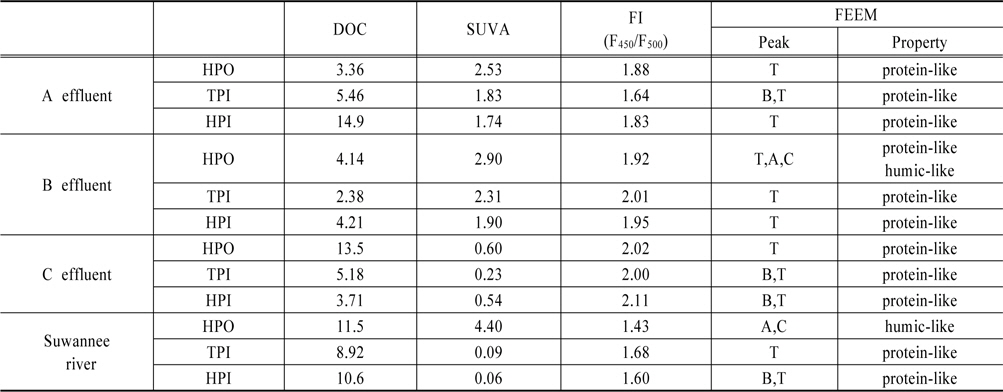
Physicochemical characteristics of effluent (A, B, C effluents) and natural (Suwannee river) organic matters (HPO = hydrophobic fraction, TPI = transphilic fraction, HPI = hydrophilic fraction)
SUVA 값이 4 ~ 5인 경우는 상대적으로 소수성이 크고 리그닌이 많은 육상기원 유기물질이며, 3 이하는 친수성의 미생물 기원 유기물질로 구분할 수 있다(Quaranta et al., 2012). 이에 따라 EfOM은 SRNOM과 비교하여 상대적으로 친수성이 높은 미생물 기원 유기물질이 주로 분포하는 것으로 판단할 수 있다. 이는 EfOM 내에 친수성 성분이 더 많이 존재하며, 미생물 기원 유기물질이 주로 분포한다고 보고한 최근 논문들의 결과와 일치한다(Quaranta et al., 2012; Kalscheur et al., 2012). 한편, 표준물질로 사용한 SRNOM은 Georgia 남부에 위치한 Suwannee 강에서 추출한 자연 유기물질로서 리그닌성분이 주를 이루며 방향족 탄소량이 많은 육상기원성 유기물질로 알려져 있다(Leenheer, 1994).
대부분의 EfOM은 대체로 2에 가까운 형광지표(FI) 값을 나타내었고, SRNOM은 1.3에 가까운 낮은 값을 나타내었다 (Table 4). 형광지표는 유기물질의 발생기원을 확인하는 방법 중 하나로서 값이 높을수록 낮은 방향성(aromaticity)을 나타내는데, 이 값이 2에 가까울수록 미생물 기원 유기물질로 구분하며 1.3에 가까운 값일수록 육상기원 유기물질로 구분할 수 있다(Hur and Schlautman, 2003; Leenheer and Croue, 2003; Mcknight et al., 2001). 따라서 EfOM의 형광지표 결과는 수처리 공정의 생물학적 처리에서 호기성 미생물로부터 생성되는 유기산, 아미노산 및 탄수화물 등의 친수성 성분 때문인 것으로 설명할 수 있다(Quaranta et al., 2012). 반면 SRNOM은 소수성이 높은 육상기원 유기물질로 주로 이루어져 낮은 형광지표 값이 나타난 것으로 판단된다. 이러한 결과는 상기의 SUVA 분석과도 일치하였다.
EfOM과 SRNOM의 FEEM 분석 결과(Table 4와 Fig. 2), 대부분의 EfOM에서 피크 B와 T (protein-like)가 나타났고, SRNOM에서는 피크 A와 C (humic-like)가 주로 검출되었다. Chen et al. (2003)은 Suwannee 강의 NOM이 주로 피크 A와 C를 나타내고, 피크 B와 T는 매우 적게 분포한다고 보고하였다. 이것은 SRNOM이 방향족탄소량이 많은 육상기원성 유기물질이기 때문인 것으로 설명할 수 있다(Leenheer, 1994). 한편, EfOM은 하폐수처리장의 생물학적 처리를 통해 생성되는 단백질 등의 친수성 물질들이 많이 포함되었기 때문에 B와 T가 주로 나타난 것으로 판단된다(Kalscheur et al., 2012; Quaranta et al., 2012). 그러나 B 방류수의 경우 소수성 분획에서 피크 A와 C(humic-like)가 검출되었는데, 이것은 폐수처리 공정으로 처리되지 않고 남은 난분해성 소수성 성분에 의한 것으로 판단된다. 상기의 물리화학적 특성 분석 결과, EfOM은 난분해성 휴믹계 유기물질과 단백질계의 유기물질이 주성분인 미생물 기원성 유기물질이며, SRNOM은 육상기원성 휴믹계 유기물질임을 확인하였다.
하폐수처리장 방류수의 48시간 물벼룩 급성독성을 측정한 결과 (Table 3), A 방류수는 0.5 TU, B 방류수는 1.38 TU, 그리고 C 방류수는 1.36 TU로 나타났다. 그러나 극성별로 분리한 EfOM과 SRNOM의 물벼룩 급성독성은 TU로 계산할 수 없어 원수에 대한 물벼룩 유영저해율로 나타내었다 (Fig. 3). 물벼룩의 급성독성(유영저해 10% 이상)은 A 방류수 소수성(HPO) 분획을 제외하고 대부분 친수성 분획(HPI)에서 나타났다. 하폐수처리장 방류수에는 수서생물에 독성을 유발하는 다양한 극성 유기오염물질들이 존재하기 때문에(Muller et al. 2007), 친수성 분획 내에 존재하는 극성의 미량유해물질들이 물벼룩에 급성독성영향을 미쳤을 것으로 사료된다. 또한, 활성슬러지 박테리아의 성장 및 분해과정에서 생성된 대사산물(soluble microbial products, SMP)들이 친수성 EfOM에 포함되어 물벼룩 유영저해를 일으킬 수 있다(Narita et al., 2007). Han et al. (2005)은 방류수의 SMP 농도가 DOC 농도와 양의 상관관계를 나타낸다고 보고한 바 있다. 한편, EfOM과 SRNOM의 극성별 분리 과정에서 시료 내 존재하는 양이온 및 중금속은 대부분 검출농도 및 독성영향농도 이하로 제거되었기 때문에 이들에 의한 독성 영향은 미미할 것으로 판단된다.
물벼룩 급성독성이 전혀 나타나지 않은 시료에 대하여 산화적 스트레스를 평가한 결과는 Fig. 4에 나타내었다. 극성별 EfOM과 SRNOM 노출에 따른 물벼룩의 CAT와 GPx의 활성과 지질과산화(MDA)는 대조구와 비교하여 유의한 차이를 보여주지 않았지만(
하폐수처리장 방류수에서 분리한 EfOM은 낮은 SUVA 값과 높은 FI, 그리고 FEEM 분석에서 피크 B와 T를 나타내어 친수성이 높은 미생물 기원 유기물질이 주성분인 것으로 확인되었다. 이는 높은 SUVA 값과 낮은 FI, 그리고 FEEM 분석에서 피크 A와 C가 주로 나타난 Suwannee River NOM의 물리화학적 특성과는 매우 차이가 있는 것으로 나타났다. 또한, 극성별로 분리된 각 시료의 물벼룩 급성독성평가에서 대부분 친수성 분획(HPI)에서 유영저해가 나타났으며, 산화적 스트레스 평가에서는 A 방류수의 친수성 분획과 B 방류수의 소수성 및 친수성 분획이 GST 효소 활성을 증가시키는 것으로 나타났다.
본 연구에서는 유기물질의 물리화학적 특성과 독성학적 영향과의 직접적인 관계를 규명하는데 한계가 있었다. 이런 점에서 물벼룩 급성독성과 산화적 스트레스를 유발하는 원인 유기물질을 규명하는 연구가 추가적으로 진행되어야 하며, 수계로 유출되는 다양한 EfOM의 물리화학적 특성과 이들이 수질오염물질들(중금속 등)과 상호작용하여 수서생물에 미치는 독성 영향을 연구할 필요가 있다.




